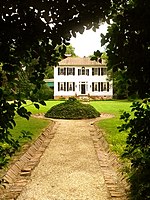Hugh Aiken House
Colonial Revival architecture in South CarolinaHouses completed in 1952Houses in Greenville, South CarolinaHouses on the National Register of Historic Places in South CarolinaNational Register of Historic Places in Greenville, South Carolina ... and 1 more
Upstate South Carolina Registered Historic Place stubs

Hugh Aiken House is a historic home located at Greenville, South Carolina. It was designed in 1948, by noted Greenville architect William Riddle Ward and built in 1952. It is a 1+1⁄2-story frame residence in the Colonial Revival style. A large, tapered stone chimney dominates the front elevation of the house. The property features an extensively landscaped lot that is a heavily wooded, natural setting with falling topography and natural springs.It was added to the National Register of Historic Places in 2003.
Excerpt from the Wikipedia article Hugh Aiken House (License: CC BY-SA 3.0, Authors, Images).Hugh Aiken House
West Avondale Drive, Greenville
Geographical coordinates (GPS) Address Nearby Places Show on map
Geographical coordinates (GPS)
| Latitude | Longitude |
|---|---|
| N 34.876666666667 ° | E -82.390555555556 ° |
Address
West Avondale Drive 54
29609 Greenville
South Carolina, United States
Open on Google Maps








